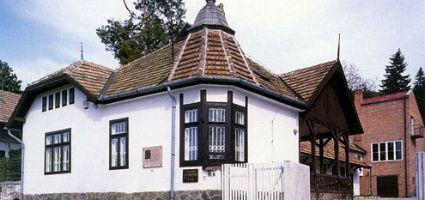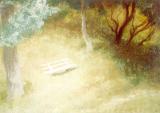2025. July 14. Monday
István Szőnyi Memorial Museum - Zebegény
 |
Address: 2627, Zebegény Bartóky u. 7.
Phone number: (27) 620-161
E-mail: szonyimuzeum1@gmail.com
Opening hours: 01.03-30.10.: Tue-Sun 9-17
|
István Szőnyi, one of the most prominent Hungarian painters of the 20th century, lived most of his life in the Szőnyi István Memorial Museum.
This house is more than just a museum in the traditional sense of the word. The purpose of the founders has been to preserve and show as much as possible of both Szőnyi's works and the milieu where these works were created. So visitors seeing the collection of Szőnyi's outstanding works the visitors can enter a world not existing any more, can get acquainted with the relics of the studio otherwise closed from the public.
Before entering the rooms of the museum let us say some words about Szőnyi's life.
He was born in 1894, in Újpest. After finishing the grammar school he was admitted to the Academy of Fine Arts in the autumn of 1913. His first master was Károly Ferenczy, who in the summer of 1914 took his students - among them István Szőnyi, as well -, who were hursaries of the Acad emy, to the Artists' Colony of Nagybánya. Szőnyi also spent the summers of 1917 and 1918 as a soldier on leave. So the young painter could get direct impressions of the colony and the life of the free school hefore and during World War I. The summers spent in Nagybánya played an important role in the artistic inducement of Szőnyi.
His first master was Károly Ferenczy, who in the summer of 1914 took his students - among them István Szőnyi, as well -, who were hursaries of the Academy, to the Artists' Colony of Nagybánya. In 1918, after he had been discharged, he got back to the Academy, this time as István Réti's pupil. (Károly Ferenczy died in 1917.) The school years proved to be short as he had been expelled because of his participation in the reform movements at the Academy.
After he had heen forced to leave the Academy he sometimes visited the Artists' Colony of Kecskemét. It was at this time that he began to deal with graphics and etching Intensively.
A decisive stage of his life and art was his marriage to Melinda Bartóky, as well as his moving to Zebegény. The landscape, the country way of life, and the nature still undisturbed made a cleep impression on the painter standing at the beginning of a promising career. At the end of his first period a series of masterpieces were produced on Zebegény topics: "Burial At Zebegény", "An Evening At Zebegény", "Motherhood" and "Village Covered With Snow".
In 1929 he was one of the first bursaries of the Hungarian Academy of Rome to get to Home but he returned home after a few months. Though he was deeply impre;sed by Roman art treasure and the Italian landscape, he could only produce works at his chosen home place in Zebegény, at the Danube Bend.
Szőnyi's palette was changing gradually; lighter, brighter and radiant colours broken with white appeared on it. He found a new technique suitable for the new view: the egg tempera, the recipe of which he worked out himself. Since his childhood he was much interested in chemistry. His technical uxperiences were published in 1941 in the hook titled "The School Of Fine Arts", of which he was both co-author and editor. At the beginning of the 30s a new pericod of his started. In this decade were his most radiant pictures created: "Evening", 1934; "Nude With Red Kerchief", 1936; "People With Umbrellas", 1939; and "The Garden Bench" 1943.
Szőnyi was appointed to a teacher of the Academy of Fine Arts in 1937. He was teaching for more than two decades. Though he was the leader of the mural department he got but a few monumental commissions. That is why he was delighted to be commissioned to paint the Saint Emery Church in Győr. He did his best to execute the program prepared by the church. The fresat of Győr can be said to be of much higher standard than the contemporary works of ecclesiastic art. His real genre, however, remained panel picture and drawing. It was Jenő Elekfy having visited Zebegény very often in the 30s under whose influence Szőnyi began to paint aquarelles, or found the most suitahle water-colour technicluc for himself: gouache. Gouache-paint with its velvety and dull surface is similar to tempera, so it was perfect for making sketches ancl stuclies. Several hundreds of snrlll paintings of such kind were produced at this time, many of which are more than a mere sketch; they are perfect compositions.
During his last years he was often ill. He spent almost all his time in Zebegény. In 1958-59 he took a pleasant trip to Italy on his claughter's invitation. The old spasm had already relaxed and he could paint some important gouache and tempera pictures under the blue sky of Italy. He was especially inspired by the sea and the harbour of Fiumiccino. In 1960 he was just preparing for the exhibition of the pictures painted in Italy. This is what he wrote about it to his daughter Zsuzsa in his last letter of 21st August 1900: "...the exhibition causes me great anxiety again. Never have I been so worried before an exhibition like now... Aging has been badly invented. One is losing the mark of genius though it has not cleveloped entirely yet."
In 9 days, on 30th August he died at his home in Zebegény. His wife lived there for another 7 years. When she had died in 1967, the Hungarian state bought the estate from the inheritors, and the history of the museum began.
This house is more than just a museum in the traditional sense of the word. The purpose of the founders has been to preserve and show as much as possible of both Szőnyi's works and the milieu where these works were created. So visitors seeing the collection of Szőnyi's outstanding works the visitors can enter a world not existing any more, can get acquainted with the relics of the studio otherwise closed from the public.
Before entering the rooms of the museum let us say some words about Szőnyi's life.
He was born in 1894, in Újpest. After finishing the grammar school he was admitted to the Academy of Fine Arts in the autumn of 1913. His first master was Károly Ferenczy, who in the summer of 1914 took his students - among them István Szőnyi, as well -, who were hursaries of the Acad emy, to the Artists' Colony of Nagybánya. Szőnyi also spent the summers of 1917 and 1918 as a soldier on leave. So the young painter could get direct impressions of the colony and the life of the free school hefore and during World War I. The summers spent in Nagybánya played an important role in the artistic inducement of Szőnyi.
His first master was Károly Ferenczy, who in the summer of 1914 took his students - among them István Szőnyi, as well -, who were hursaries of the Academy, to the Artists' Colony of Nagybánya. In 1918, after he had been discharged, he got back to the Academy, this time as István Réti's pupil. (Károly Ferenczy died in 1917.) The school years proved to be short as he had been expelled because of his participation in the reform movements at the Academy.
After he had heen forced to leave the Academy he sometimes visited the Artists' Colony of Kecskemét. It was at this time that he began to deal with graphics and etching Intensively.
A decisive stage of his life and art was his marriage to Melinda Bartóky, as well as his moving to Zebegény. The landscape, the country way of life, and the nature still undisturbed made a cleep impression on the painter standing at the beginning of a promising career. At the end of his first period a series of masterpieces were produced on Zebegény topics: "Burial At Zebegény", "An Evening At Zebegény", "Motherhood" and "Village Covered With Snow".
In 1929 he was one of the first bursaries of the Hungarian Academy of Rome to get to Home but he returned home after a few months. Though he was deeply impre;sed by Roman art treasure and the Italian landscape, he could only produce works at his chosen home place in Zebegény, at the Danube Bend.
Szőnyi's palette was changing gradually; lighter, brighter and radiant colours broken with white appeared on it. He found a new technique suitable for the new view: the egg tempera, the recipe of which he worked out himself. Since his childhood he was much interested in chemistry. His technical uxperiences were published in 1941 in the hook titled "The School Of Fine Arts", of which he was both co-author and editor. At the beginning of the 30s a new pericod of his started. In this decade were his most radiant pictures created: "Evening", 1934; "Nude With Red Kerchief", 1936; "People With Umbrellas", 1939; and "The Garden Bench" 1943.
Szőnyi was appointed to a teacher of the Academy of Fine Arts in 1937. He was teaching for more than two decades. Though he was the leader of the mural department he got but a few monumental commissions. That is why he was delighted to be commissioned to paint the Saint Emery Church in Győr. He did his best to execute the program prepared by the church. The fresat of Győr can be said to be of much higher standard than the contemporary works of ecclesiastic art. His real genre, however, remained panel picture and drawing. It was Jenő Elekfy having visited Zebegény very often in the 30s under whose influence Szőnyi began to paint aquarelles, or found the most suitahle water-colour technicluc for himself: gouache. Gouache-paint with its velvety and dull surface is similar to tempera, so it was perfect for making sketches ancl stuclies. Several hundreds of snrlll paintings of such kind were produced at this time, many of which are more than a mere sketch; they are perfect compositions.
During his last years he was often ill. He spent almost all his time in Zebegény. In 1958-59 he took a pleasant trip to Italy on his claughter's invitation. The old spasm had already relaxed and he could paint some important gouache and tempera pictures under the blue sky of Italy. He was especially inspired by the sea and the harbour of Fiumiccino. In 1960 he was just preparing for the exhibition of the pictures painted in Italy. This is what he wrote about it to his daughter Zsuzsa in his last letter of 21st August 1900: "...the exhibition causes me great anxiety again. Never have I been so worried before an exhibition like now... Aging has been badly invented. One is losing the mark of genius though it has not cleveloped entirely yet."
In 9 days, on 30th August he died at his home in Zebegény. His wife lived there for another 7 years. When she had died in 1967, the Hungarian state bought the estate from the inheritors, and the history of the museum began.
